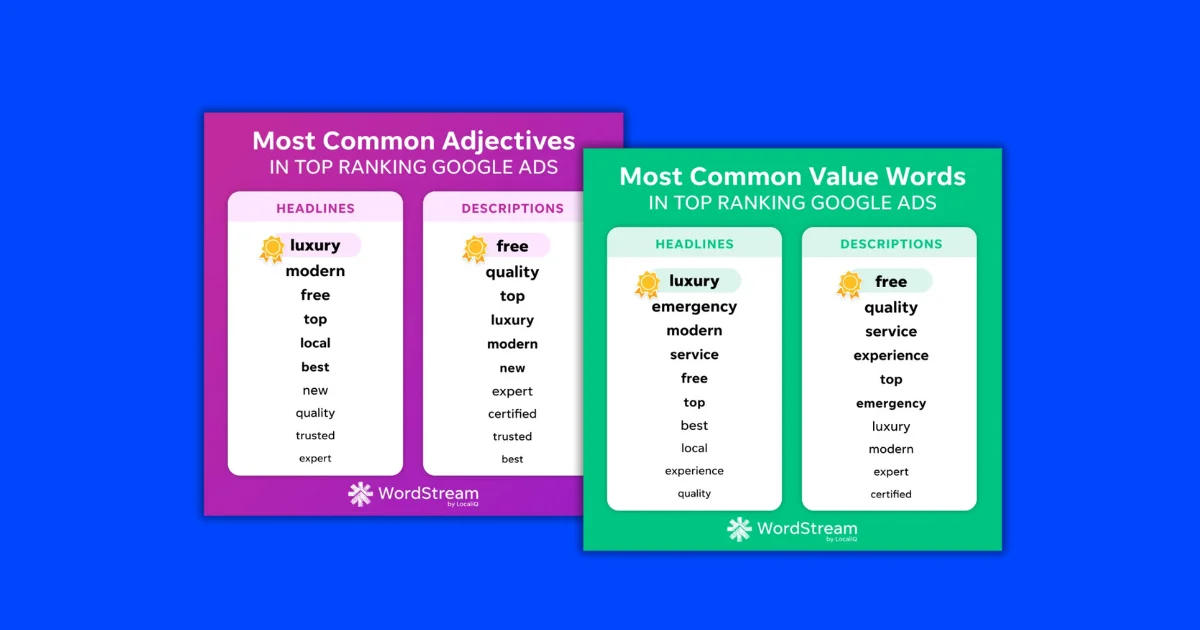Great ad copy is critical to the success of any Google Ads campaign. You only have a few seconds to catch a searcher’s attention and communicate why they should pick you. Your ad copy needs to show relevance and value fast!
So, we wondered: What words and phrases show up the most in highly visible ads?
To find out, we analyzed 180 ads that achieved top positions, as measured by their Google Ad Rank, breaking down a total of 1,750 headlines and 550 descriptions to find what copy they had in common.
We distilled our findings into nine fascinating insights, followed up with tips you can apply to your own Google Ads to make them pop, persuade, and perform.
Contents
Before we dive into the findings, a quick caveat: Ad Rank is determined by multiple factors, including (according to Google) “your bid amount, the quality of your ads and landing page, the Ad Rank thresholds, the competitiveness of an auction, the context of the person’s search, and the expected impact of assets and other ad formats.” Ad copy is just one factor that impacts your search ad performance, so keep that in mind as you consider these learnings!
1. “Today” is the most common word in highly visible Google Ads
230 of the Google Ads in our sample used the word “today” in either the headline or the description. That made it the most commonly used word in this cohort.
Here’s an example of how a Google ad uses “Today” to add a little urgency to its call to action. (Note that these examples are not necessarily ads from our sample group.)
“Call” was a close second, appearing 198 times. “Luxury” and “now” were also highly represented in headlines, while “more” and “free” showed up in over 50 ad descriptions.

Tip: Use urgency to drive action
It’s no surprise that so many of these Google Ads use words that amplify a sense of urgency. Besides the top two, words like “emergency,” “limited,” and “exclusive” were also common.

Stoking a sense of urgency is a foundational tactic of great copywriting. It’s an especially effective tactic for high-intent promotional placements like Google Ads. When someone searches for a “plumber” or a “coffee shop near me,” it’s a safe bet they’re looking for a solution right away.
🛑 Want to make sure all your Google Ads are performing at their peak? Use our Free Google Ads Grader.
2. “Now,” “Free,” and “Get” are among the most common power words
A power word is a persuasive, emotionally charged term used in copywriting to grab attention, inspire action, and trigger a strong response from the reader.
As we saw, power words that create urgency (such as “today” and “now”) dominate both headlines and descriptions. But value words like “get,” “free,” and “affordable” were right behind them. And trust-building terms like “trusted,” “safe,” and “certified” rounded out the list of most persuasive power words.
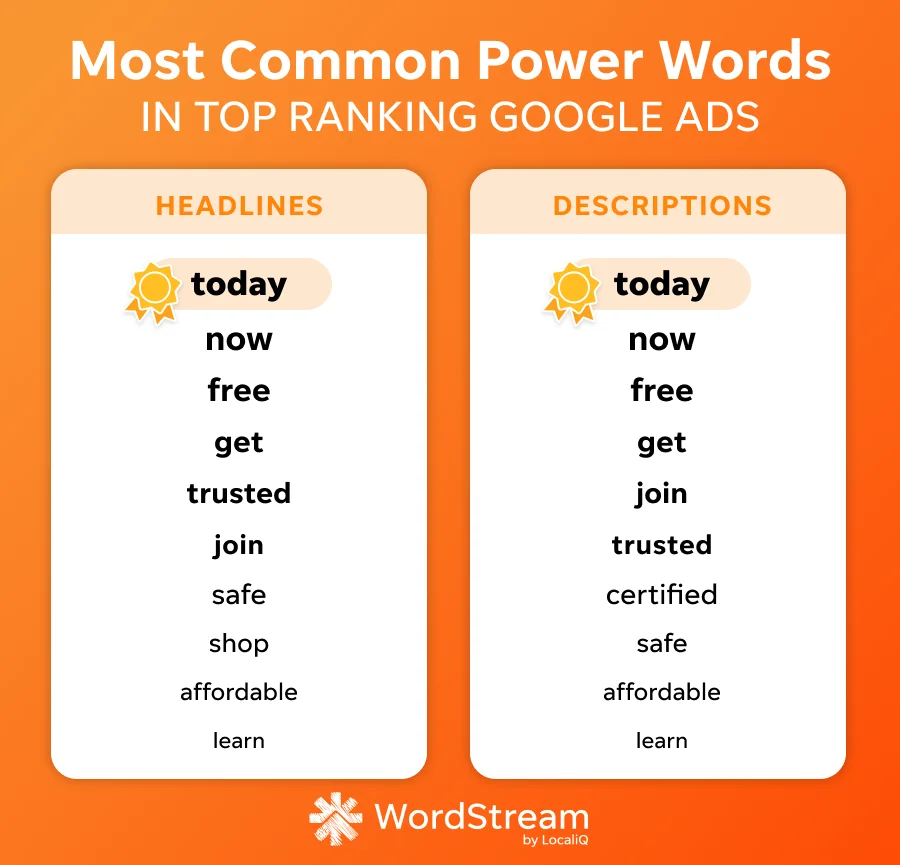
Overall, power words appeared in 15% of the headlines and 36% of the descriptions.
Tip: Use power words to build trust and drive action
Power words are effective in Google Ads because they appeal to the three decision-making processes a buyer employs to pick a solution: ethos (trust; e.g., “certified”), pathos (emotion, e.g., “safe”), and logos (logic, e.g., “free”).
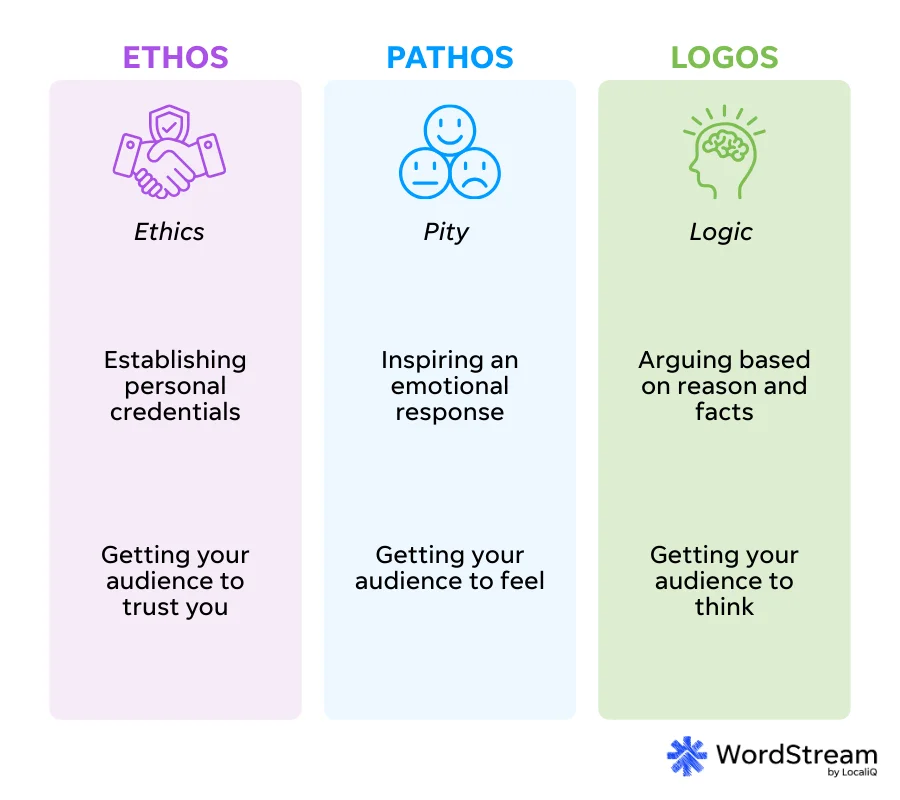
Even though urgency words were the most represented in our study, there were plenty of power words used to trigger feelings of trust, community, and financial security.
The trick is choosing which emotions your target customer will respond to most when seeing your ad. And it could change, depending on their search. For example, someone who searches for “sink replacement” vs. “emergency plumber” will respond to two different types of power words.

Ad results for the search term “sink replacement” use power words that focus on trust and value.
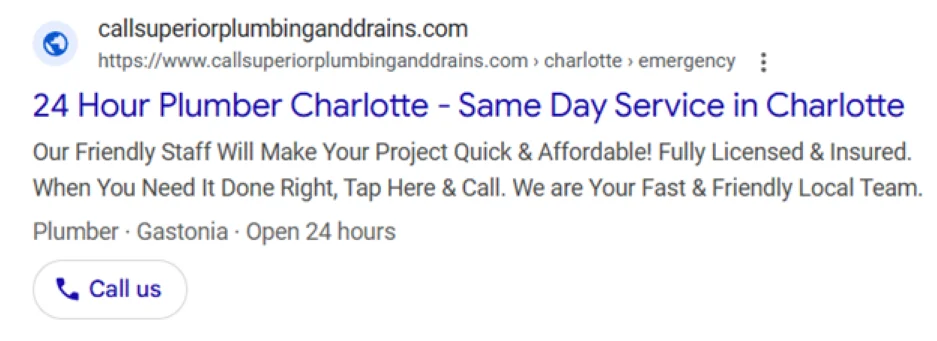
An ad for “emergency plumber” includes more urgent power words.
3. Many ads with a high Ad Rank include numbers
358 ads in this study included numbers in either the headline or description (or both).
Numbers were used for a variety of reasons, including:
- Highlighting savings: “Save $2,500” or “0% financing”
- Showing experience: “100 years of combined experience” or “Locally trusted since 2002”
- Explaining the scope of an offer: “Get access to 5 locations” or “Over 30 weekly classes”
Tip: Numbers get attention and prove assertions
Numbers in ads serve two primary purposes. First, they stand out in a sea of text. That’s even more true when you add a dollar or percent sign. In an ad like this, many eyes will land on “70,000” or $5M before any of the words.
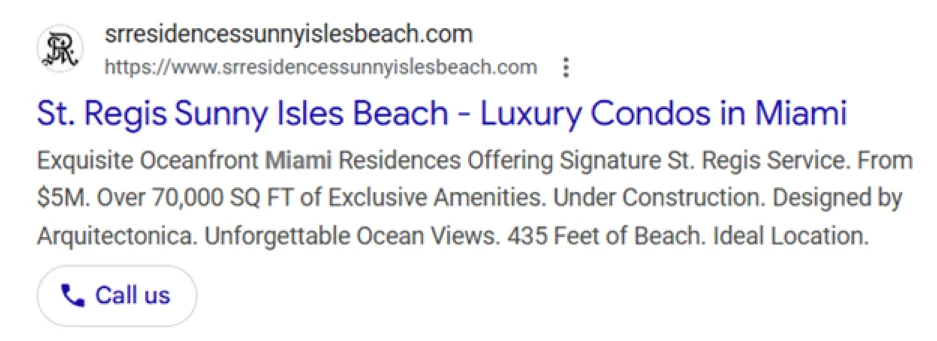
Second, numbers create specificity, and specificity builds trust. You can say you’re experienced, but adding “100 years of combined experience” holds a lot more weight.
You can get a bit creative here, too. Instead of writing “personalized service,” try “1:1 concierge support.”
4. Quality and trust trounced price as the leading value words
A value proposition is a clear statement that explains the unique benefit a product or service offers, how it solves a customer’s problem, and why it’s better than competing alternatives.
In our study, just over half (56%) of descriptions and nearly a third (28%) of headlines used a word that clearly indicated a value proposition.
Surprisingly, trust and quality-related value words (e.g., “quality,” “luxury,” and “expert”) occupied many more of the top spots compared to price-focused words.
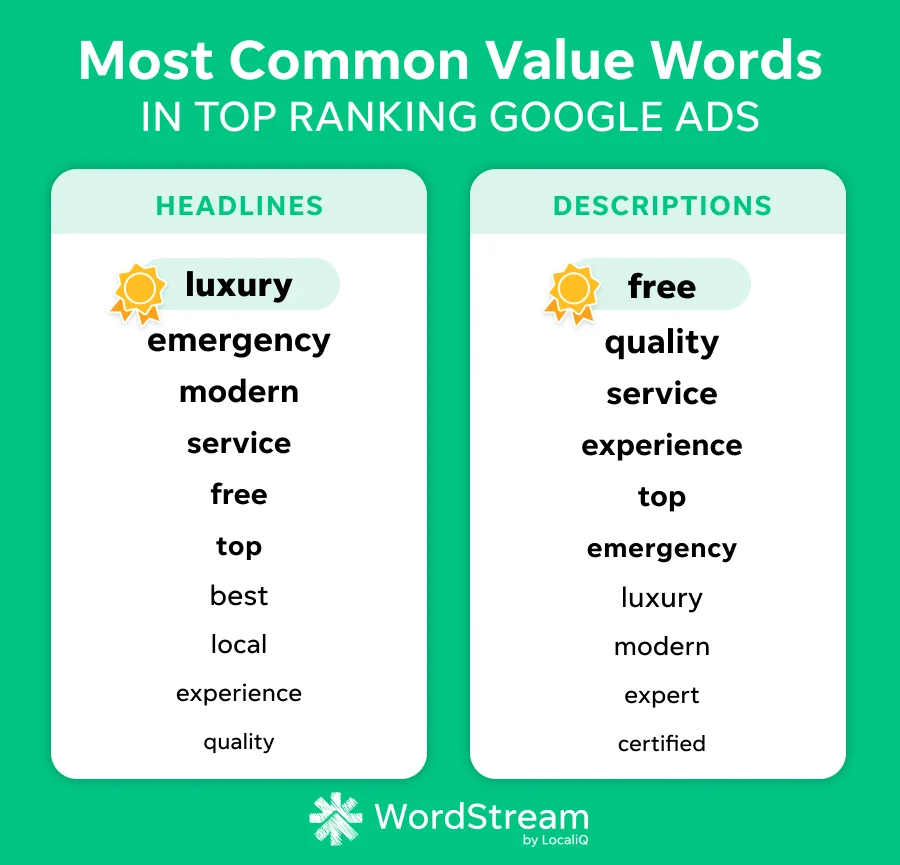
Tip: Don’t assume low price is the main decision driver
We fully expected to see variations of low-price terms splattered across most of this ad copy. But in fact, the word “price” only appeared 19 times, and most of those instances were in headlines. In fact, just six headlines and five descriptions included a dollar sign.

It’s a great reminder that while many buyers may ultimately shop you on price, their first instincts are to find the highest-quality, most reliable option. So, make sure your ad copy shows off those qualities.
💡 Eliminate the silent budget thieves crushing your Google Ads success! Download 6 Common (But Costly) Google Ads Mistakes
5. “Top” topped the list of superlatives
Feel free to use your absolute best superlatives in your Google Ads copy. In fact, “best” is a pretty good option, since it appeared in 24 headlines and 13 ad descriptions.
But if you really want your copy to pop, try “top” to describe your services and solutions. A total of 53 of the most visible ads included that supreme superlative.
“Premier,” “ultimate,” and “superior” were peppered into several headlines and descriptions, too.

Tip: Super ad copy has superlatives
There’s a lot of room to get a jump on your competition here. Only 4% of headlines and 10% of descriptions included a superlative.
The biggest lesson here is that Google Ads copy is no time to be subtle. If you have the best service, top technicians, or the highest-rated product, make that a centerpiece of your ad.

6. The most common call to action was a phone call
Compelling, no-nonsense calls to action are among the most important copywriting devices in any promotional message. In our study, we found them to be among the most prominent, with 54% of descriptions and 12% of headlines including a clear CTA.
And it looks like the most common request by far was the good old phone call, as in “call us for a quote.” Ads requested that action a total of 198 times, more than three times the number of times compared to the runner-up, “get.” This is smart copywriting because for many businesses, calls are the most valuable type of lead.
“Schedule” and “book” are strong contenders, especially when you consider they’re often used interchangeably.

Tip: Every ad should have a CTA
A clear call to action is the best way to tell a searcher exactly what you want them to do next. And ideally, it should also tell them what they’ll get when they do it (think: “join now for your discount”).

Now, which CTA words work best depends on your business. If your phone lines are open, give “call” a chance first since it clearly delivers results. Beyond that, choose an action verb that best describes what a customer needs to do.
7. When it comes to adjectives, “luxury” was used the most
The word “luxury” was mentioned in headlines more than any other adjective. It also appeared in descriptions more than all but three other descriptors.
When you account for how many ads used words like “modern” and “quality,” you get a good sense of the overall theme captured by a good portion of these highly ranked ads
“Free” was the only value-centric adjective used heavily in these ads, although it was #1 for descriptions.
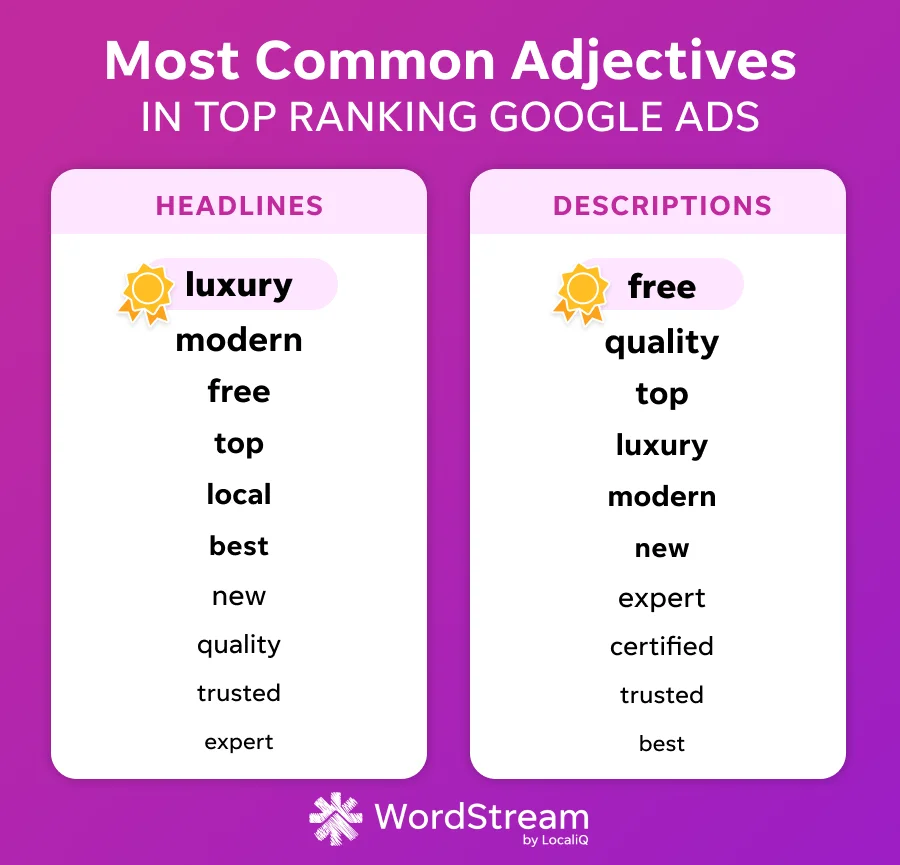
Tip: Take advantage of more adjectives
It makes sense that there’s a lot of crossover between the most-used adjectives and the most effective value propositions. But what is a little surprising is that adjectives were only used in 20% of the headlines (and less than 50% of the descriptions).
A strong adjective is an easy way to boost the perceived value of whatever you sell. Even a simple “expert” placed in front of “car wash” puts a bit of panache on your promotion.

Adverbs were exceedingly scarce—just 2% of headlines and 8% of descriptions use them. The most used adverbs, “today” and “now,” mirrored the most popular words.
8. The most popular headline punctuation is not what we thought!
The most used punctuation in the headlines of these ads are the ampersand (130 uses) and the hyphen (118).
These results aren’t shocking, since hyphens and ampersands do a lot of heavy lifting in making brief copy punchier (like saying something is “click-worthy” instead of “worthy of clicks”) and reducing overall character count.
What did stand out is how rarely headlines used exclamation points (5) or question marks (4). Ads are meant to drum up excitement and curiosity—things those punctuation marks are good at doing.
Overall, punctuation was included in 78% of the top headlines.
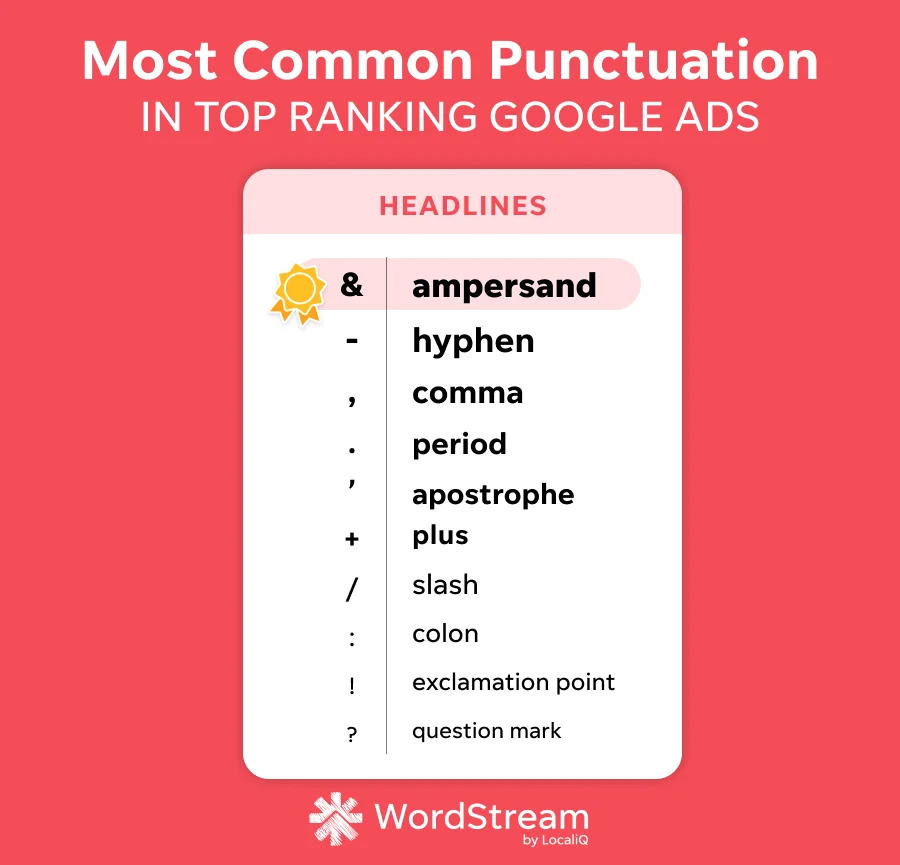
Tip: Keep your titles professional
The rare use of exclamation points and question marks suggests that restrained, professional copy might beat clickbaity, sensationalistic headlines.
We also noted that 78% of these headlines used title case, which is a bit more formal than sentence case.
It’s possible that measured, professional headlines generated more trust than the splashy ones that shouted for attention.
9. Dynamic keyword placement isn’t used often in these ads
Dynamic keyword placement is a feature of Google Ads that automatically inserts the search query a user typed into the ad copy. The idea is to make the ad more relevant to that particular shopper.
In theory, dynamic keyword placement is a great way to personalize ad copy. If you’re searching for “affordable life insurance” and one of the three ads that pop up uses that exact phrase, you might be more drawn to it.
In practice, it wasn’t a popular feature in our study. It was only used in 12 of the Google Ads on our list.
Tip: Try dynamic keyword placement, but don’t rely on it
The results align with our own assessment of dynamic keyword placement. It’s an easy tactic to try that can improve your results. But it has downsides that suggest moving with caution.
For example, dynamic keyword insertion can lead to headlines that exceed allowed character limits, misspelled keywords showing up in your ads, and ads that don’t 100% align with the searcher’s intent.
The best guidance here is to test a few ads using dynamic keywords against your standard practice (applying the learnings from this report as a guide).
8 quick Google Ads stats
Here’s a round-up of the statistics from our study of the most highly visible Google Ads headlines and descriptions.
- “Today” is the most commonly used word in Google Ads with a high Ad Rank.
- Descriptors like “luxury,” “quality,” and “expert” appear far more often than mentions of low price in ads that achieved top positions.
- Nearly 10% of Google Ads in this study use at least one superlative like “best.”
- Nearly one in four of high-ranking Google Ads have a clear call to action in the headline, description, or both.
- Over 30% of the Google Ads we surfaced include clear value words like “convenience” in the copy.
- Only 0.005% of highly ranked Google Ads use dynamic keyword placement.
- About 14% of Google Ads with high Ad Rank use punctuation.
- 15% of the most visible Google Ads feature a number in the copy.
Write your best Google Ads copy ever
The best way to use this research is to apply one or two of the tips to an A/B test and see which changes give your ads a boost with your unique audience and for your unique brand. Take the winner, add another one or two ideas from this list, and test again.
After a few trials, you’ll end up with campaigns that way outperform not only your previous ads, but anything your competitors post as well.
Of course, we’re always available to help. First, try WordStream’s Google Ads Grader to get a free and complete audit of your Google Ads. Then, contact us and we’ll show you how our marketing solutions cut through the noise to deliver more leads and sales.
About the data
This report was created based on data from 180 of the highest-performing LocaliQ-run campaigns by Ad Rank in Google Ads running in the US from January 2024 to August 2025. Thanks to LocaliQ’s Associate Product Manager—Media Ads Brad Pierce for assistance with this project.

